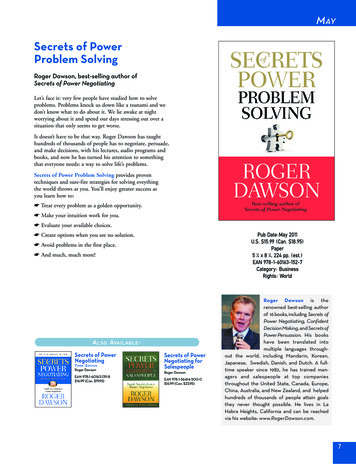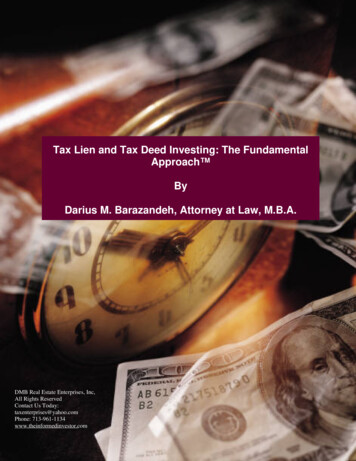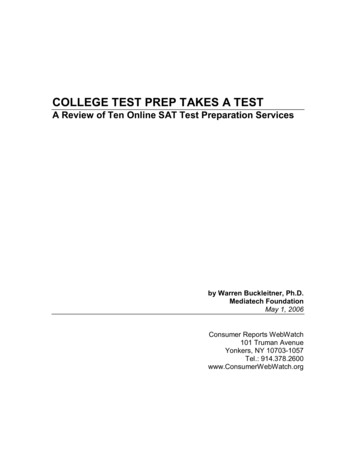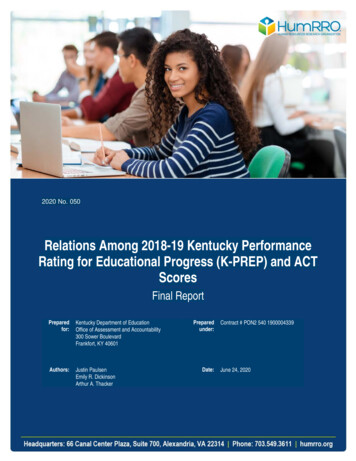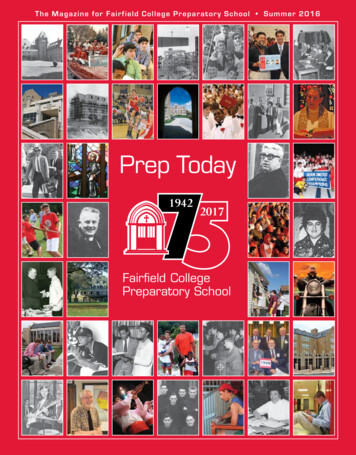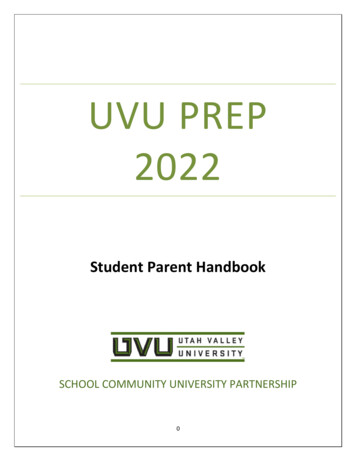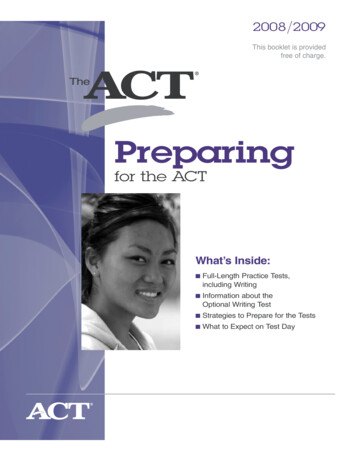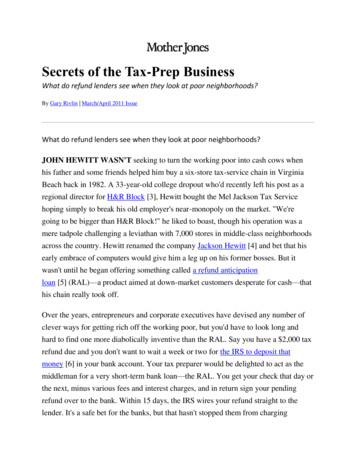
Transcription
Secrets of the Tax-Prep BusinessWhat do refund lenders see when they look at poor neighborhoods?By Gary Rivlin March/April 2011 IssueWhat do refund lenders see when they look at poor neighborhoods?JOHN HEWITT WASN'T seeking to turn the working poor into cash cows whenhis father and some friends helped him buy a six-store tax-service chain in VirginiaBeach back in 1982. A 33-year-old college dropout who'd recently left his post as aregional director for H&R Block [3], Hewitt bought the Mel Jackson Tax Servicehoping simply to break his old employer's near-monopoly on the market. "We'regoing to be bigger than H&R Block!" he liked to boast, though his operation was amere tadpole challenging a leviathan with 7,000 stores in middle-class neighborhoodsacross the country. Hewitt renamed the company Jackson Hewitt [4] and bet that hisearly embrace of computers would give him a leg up on his former bosses. But itwasn't until he began offering something called a refund anticipationloan [5] (RAL)—a product aimed at down-market customers desperate for cash—thathis chain really took off.Over the years, entrepreneurs and corporate executives have devised any number ofclever ways for getting rich off the working poor, but you'd have to look long andhard to find one more diabolically inventive than the RAL. Say you have a 2,000 taxrefund due and you don't want to wait a week or two for the IRS to deposit thatmoney [6] in your bank account. Your tax preparer would be delighted to act as themiddleman for a very short-term bank loan—the RAL. You get your check that day orthe next, minus various fees and interest charges, and in return sign your pendingrefund over to the bank. Within 15 days, the IRS wires your refund straight to thelender. It's a safe bet for the banks, but that hasn't stopped them from charging
astronomical interest rates. Until this tax year [7], the IRS was even kind enough to letlenders know when potential borrowers were likely to have their refund garnishedbecause they owed back taxes, say, or were behind on child support.Hewitt didn't invent the refund anticipation loan. That distinction belongs to RossLongfield [8], who dreamed up the idea in 1987 and took it to H&R Block CEOThomas Bloch. "I'm explaining it," Longfield recalls, "but Tom is sitting there going,'I don't know; I don't know if people are going to want to do that.'"Tax-prep shops are as common as fast-foodjoints in many low-income neighborhoods—there are at least half a dozen on onethree-block stretch of South Broadway in Yonkers, N.Y., where thesephotographs were taken. A few offer reasonably priced accounting, while otherscharge hundreds of dollars for 20 minutes of work.But Longfield knew. He worked for Beneficial Corp., a subprime lender specializingin small, high-interest loans for customers who needed to finance a new refrigerator ordining-room set. His instincts told him the RAL would be a big hit—as did the pollingand focus groups he organized. "Everything we did suggested people would love it—love it to death," he says.He also knew Beneficial would make a killing if he could convince tax preparers—inexchange for a cut of the proceeds—to peddle this new breed of loan on hisemployer's behalf. Ultimately, Longfield persuaded H&R Block to sign up. But noone was as smitten as John Hewitt—who understood that people earning 15,000 or
20,000 or 25,000 a year live in a perpetual state of financial turmoil. Hewitt beganopening outposts in the inner cities, Rust Belt towns, depressed rural areas—anywherethe misery index was high. "That was the low-hanging fruit," he says. "Going intolower-income areas and delivering refunds quicker was where the opportunity was."Customers wanting a RAL paid Jackson Hewitt a 24 application fee, a 25processing fee, and a 2 electronic-filing fee, plus 4 percent of the loan amount. On a 2,000 refund, that meant 131 in charges—equivalent to an annual interest rate ofabout 170 percent—not to mention the few hundred bucks you might spend for taxpreparation. "Essentially, they're charging people triple-digit interest rates to borrowtheir own money," says Chi Chi Wu, a staff attorney at theNational Consumer LawCenter [9].In 1988, the first year he began offering the loans, Hewitt owned 49 stores in threestates. Five years later, he had 878 stores in 37 states. And five years after that, whenCendant Corp.—the conglomerate that owned Avis, Century 21, and Days Inn—bought Jackson Hewitt for 483 million, his earliest backers received a 2 millionpayout on every 5,000 they'd invested. Today, with 6,000 offices scattered across thecountry, Jackson Hewitt is more ubiquitous than KFC, and has about as manyimitators.THERE WOULD BE NO refund anticipation loans, of course, without tax refunds.And by extension there would be no RALs without the Earned Income TaxCredit [10], the federal anti-poverty initiative that served as the mother's milknourishing the instant-refund boom. Welfare reform was the catalyst for the EITC,which was aimed at putting extra cash in the pockets of low-income parents whoworked. What motive does a single mother have to get a job, conservative thinkersasked, if there was scant difference between her monthly take-home pay and a welfarecheck? It was Richard Nixon who first floated the idea that led to the Earned IncomeTax Credit; Ronald Reagan dubbed it "the best pro-family, the best job creation
measure to come out of Congress." In 2007, the US Treasury paid out 49 billion to25 million taxpayers [11]."It's a beautiful, beautiful thing that Richard Nixon gave thecountry," muses the founder of one tax-prep chain."It's a beautiful, beautiful thing that Richard Nixon gave the country," muses FesumOgbazion, founder of Instant Tax Service [12], the country's fourth-largest tax-prepchain behind H&R Block, Jackson Hewitt, and Liberty Tax Service [13]—the outfitHewitt founded after leaving his eponymous company. On this year's slidingscale [14] (PDF), a single mother of two making 16,000 a year gets a 5,000 taxrefund; if she earns 25,000, her windfall is 3,200. "People basically startbombarding us with calls at the end of December," Ogbazion says. They all ask thesame few questions: "'Can I do my taxes with my pay stubs?' 'Do I have to wait for theW-2?' It's nuts." The IRS starts accepting returns around January 15. By midFebruary, Ogbazion will have filed on behalf of more than four-fifths of his clients."By the time the rest of the world is starting to get serious about their taxes," he says,"I'm already thinking about next year."Ramon Dalmasi's shop.
Ogbazion is a native of Ethiopia whose family moved to the United States when hewas nine years old. He opened his first tax-prep shop when he was a sophomore incollege. By that point, several large banks had jumped into the business. Ogbazionbegan brokering RALs on behalf of Bank One, now part of JPMorgan Chase. By1999, when he sold his chain to Jackson Hewitt for 3 million, Ogbazion was up to 26shops, all in the greater Cincinnati area. Just 27 at the time, he decided to start a newchain, Instant Tax, setting up headquarters in Dayton, Ohio. By that point, the mostdesirable spots—those in the city's poorest precincts—were taken, so he startedopening stores in working-class suburbs. "I moved to where opportunities were stillavailable," he says with a shrug when I meet him at his stylish office in one ofDayton's pricier downtown towers. Today, Instant Tax boasts about 1,000 outlets,mostly owned by independent operators who pay Ogbazion a one-time 34,000franchising fee, plus 20 percent of their gross revenues."We recommend that you locate your office where the household income is 30,000or less," the Instant Tax manual counsels. Each franchisee attends a week of trainingsessions where "unbelievable emphasis was put on poor minorities," according toformer franchisee Habtom Ghebremichael, who recalls a trainer telling his group, "Wecater to the 'hood." His archetypal customer, Ogbazion says, is an assistant manager ata fast-food restaurant earning 19,000 a year. "They've burned the banks," he says."They've bounced too many checks. They've mismanaged their finances." Experiencehas taught him that a few amenities (a ficus tree, free coffee, TV in the reception area)go a long way in making customers feel welcome. "At the check-cashing place,they're talking to someone behind bulletproof glass," Ogbazion continues. "Thewelfare building—you can imagine what that's like. Here, we treat them well, andthey want to come back."REFUND ANTICIPATION loans aren't the primary source of revenue for InstantTax, Jackson Hewitt, or any of the tax millheres. The main moneymaker has alwaysbeen the hefty fees they charge to prepare returns. But the RAL gets people throughthe door. "Obviously, that's why people come to us," Ogbazion says. "Because we can
get them their money quickly." Previously, those customers might have struggled ontheir own or taken advantage of free help that the IRS and others provide to low- andmoderate-income taxpayers. The RAL also ensures that the client pays in full, andmaybe that's the real genius of it: The preparer's fees and finance charges are takendirectly from the refund [5].Let's say you earn roughly 25,000 a year as a file clerk. You've got two kids and anelderly dependent. You don't itemize, you qualify for the Earned Income Tax Credit,and you're due a federal refund of 3,978. Here are some tax-prep options, based onone real-life example.*a few stamps06-8 weeksfree software if income 58K08-15 daysfree human tax-prep if income 49K08-15 daysfree for "simple" returns08-15 days 95- 125**2-3% 8-15 days 431***11% same day* From a 2010 "mystery shopper" study by Arkansans Against Abusive PaydayLending.** One CPA said our mystery 1040 was a job he'd only do pro bono. It "would take15 minutes," noted another.*** Includes 350 tax-prep fee, 61 RAL fee (57% APR), and 20 "technologyaccess" fee.Longfield concedes that his innovation drains money from what is arguably thenation's most effective anti-poverty program, but he says it's the customer'sprerogative. As for Ogbazion, he views Instant Tax and its competitors as beacons ofhope. "Look at where our stores are," he says. "There's no Gap. There's no Nordstrom.We employ people from the neighborhood. We're paying rents in thoseneighborhoods. We're contributing to the tax base." The flip side of this argument is
that instant tax mills are part of a phenomenon that lasts barely four weeks yet sucksup roughly 4 billion each tax season."These businesses are in this neighborhood for one reason: They see they can make akilling here," says Ramon Dalmasi, an accountant with a front-row seat on the growthof the instant tax business. Dalmasi opened a bookkeeping business in the Bronx in1997 and watched as chain after tax-prep chain popped up on commercial strips in hiscommunity. A few years ago, he relocated to Yonkers, an aging suburb just north ofNew York City, and found the same chains there as well. "They don't see peoplestruggling to put food on the table," he says. "They just see people who can makethem millions." Even without a RAL, a working parent who qualifies for the EITCoften pays 300 or more at a tax mill. Dalmasi, a CPA who teaches accounting atnearby Lehman College, charges that same client 75 or 100. "Why should I chargeanything more than that," he asks, "when it's taking me 20 minutes?"Others in the poverty business haverephrased that question: Why not get into a business where 20 minutes of work canyield a few hundred dollars in fees? Outfits like Refunds Today [15] offer software("requires absolutely no tax preparation knowledge") that walks enterprisingpawnbrokers or check-cashers or payday lenders through the process. Why settle forthe 100 you'll make cashing a customer's tax-refund check, asked a guest columnistfor Cheklist [16], the trade publication for the nation's check-cashers, when a fat 400payday "sits 10 minutes of data entry away?" Then there's Tax Max, which claims that3,000 auto dealers use its software, and TaxStar, whose "dealership portal" features
testimonials from sales managers grateful for a way to put a few thousand dollars—instantly!—in the pockets of a customer, right there on the lot.In 2008, more than 8 million Americans shelled out 738 million for refundanticipation loans, according to industry watchdogs (PDF [17]). When I visitedRamon Dalmasi, he told me he discourages customers from taking a RAL—but he didhave a neon "Rapid Refunds" sign in his window and several posters promisinginstant cash. "We're in a poor neighborhood," he explained. Advocates scored avictory of sorts when, starting in 2008, the big tax chains and lenders lowered theirRAL fees. "We basically shamed them into it," says consumer attorney Wu. Even so,a customer seeking an instant refund at H&R Block last year paid a 29.95 "refundaccount fee," a 24.95 "instant RAL surcharge," and a 20 "check processing fee" ontop of a finance charge tied to loan size. On a 2,000 refund, that worked out to 128percent annual interest.BY THE WINTER of 2010, there were six tax-prep stores on the 400 block of SouthBroadway, a scruffy commercial strip in Yonkers that also hosted three 99-cent stores,a pair of check-cashing outlets, and a Rent-A-Center. H&R Block occupied the primespot, a few steps from where a bus disgorged passengers returning from the city. Ahalf-block to the north sat a Jackson Hewitt. A half-block to the south, across thestreet from Dalmasi's shop and a few doors away from a storefront with a Liberty TaxService sign in the window, was Alan Meister's Instant Tax franchise.Ogbazion had arranged for me to spend time with Meister, one of his franchisees,promising, "You'll see for yourself the quality of service we provide." It was a narrowsliver of a store, barely wide enough for the four desks that sat one behind anotheragainst the wall. Meister set up shop in the fall of 2009, after several decades withErnst & Young. He lives 20 miles away in Chappaqua, where the median householdincome is 207,747 (and where the Clintons own a home), but leased a storefront inthis mixed-race community because its household income was about a quarter as
much. Another huge plus, he told me, "was there was a very high proportion of peoplereceiving the Earned Income Tax Credit."It was Meister's rotten luck that in December 2009, only weeks before he was toopen, federal regulators ordered Santa Barbara Bank & Trust [18] out of the RALbusiness. Although tax loans were its most profitable division, the bank had takenhuge losses in the subprime meltdown and had failed to meet its capital requirements.It was Santa Barbara that underwrote the RALs Instant Tax offered, and it was too lateto find another bank.So Meister adapted. The sign in his windowread, "Stop in, get your taxes done, and leave with TaxCash the same day!" But whenanyone inquired about a RAL, he pontificated about the banking crisis and how credithad basically dried up for everyone. "There might be some stores advertising it," hesaid (to me and anyone who stopped in), "but the reality is that few will actually get arefund anticipation loan." In fact, competitors down the street were still offeringRALs—small businesses and the middle class may have been starved for credit, butbanks were still more than willing to play emergency banker to the working poor, atleast when the loans were more or less guaranteed by the IRS. Meister was similarlyevasive about pricing. "A couple of hundred dollars," he'd say, though invariably hecharged 300 and up. When I pressed him, Meister insisted that he was chargingaround 200, but there was a 59 e-filing fee and a 100 "technology" fee that went tothe company licensing its software to Instant Tax. (Ogbazion told me the softwarecompany charged 17 per return, not 100.)
One customer who bought Meister's services early that January was Fred B. Newman,a custodian at a local hospital. A father of two, Newman anticipated a refund ofaround 4,000. He was behind on his electric bill and carrying a balance on a highrate credit card. "Nothing too bad," he said, though he wanted his money as fast aspossible. Meister, unable to offer him a RAL, talked him instead into buyingsomething called a refund anticipation check, or RAC.It wasn't clear why Newman would pay 42 for a RAC, which doesn't ensure aninstant refund. The RAC is meant for customers who lack bank accounts or who can'tafford to pay up front for tax preparation—it's basically a charge for a temporaryaccount where the IRS can deposit the refund, and from which a preparer can deducthis fees. Newman already had a checking account and a means of payment, butMeister put him down for a RAC without bothering to explain its purpose. "I canmake that 42 go away if you don't mind waiting on the IRS," he said when Newmannoticed the extra charge. He added that if Newman was worried about the price (hisbill now totaled almost 400), he could simply wait six to eight weeks—the time ittakes for a check to arrive when you're filing by mail."I can't wait that long.""It's your call," Meister replied.In fact, Newman was already paying Meister an e-filing fee and thus, according to theIRS, would be getting his money no more than 15 days after filing—with or without aRAC.AT THE TIME, Meister told me he hoped to open a dozen or more Instant Tax shopsaround New York. In the end, though, he gave up after only one tax season; 2010 wasa miserable year, in no small part because he couldn't offer the refund loans. JacksonHewitt also relied on Santa Barbara for some of its loan volume, so half of its storeswere unable to offer a refund loan last year.
While bank regulators in Washington have stopped shortof outlawing refund loans, they've managed to make lifemore difficult—and therefore less profitable—for the banks.The post-subprime environment has been tough for low-rent tax preparers. "Thecurrent administration does not look favorably on these products," says VishnuLekraj, a stock analyst who follows the tax-prep chains for Morningstar. While bankregulators in Washington have stopped short of outlawing RALs, they've managed tomake life more difficult—and therefore less profitable—for the banks. The newofficial line is that so long as tax preparers are selling these loans, the banks mustsupervise them more closely: Put better audits in place. Make sure they adequatelytrain their people. Monitor their marketing efforts. Last April, shortly after the end ofthe 2010 tax season, JPMorgan Chase announced it was getting out of refundloans [19] altogether, leaving 13,000 independents, including Ramon Dalmasi,scrambling for an alternative lender.The industry took an even bigger punch in August, when the IRS announced it wouldstop providing lenders with a "debt indicator" letting them know whether a taxpayerwas likely to have a refund garnished for back taxes or other debts. ("It's a productprovided by the private sector," IRS spokesman Dean Patterson said of the RAL,though he declined to explain the agency's decision. "We neither endorse it nor try todissuade people from using it.") In the past, according to a study by one consumergroup, the IRS gave the thumbs-down to at least 1 in 12 people seeking a refund loan.Without that handy information, these loans are much riskier. HSBC, the Londonbased bank that was under contract with H&R Block to underwrite tax loans through2013, announced that without the debt indicator, it was getting out of the RALbusiness. Block sued [20], and the two parties came to an agreement, but then, justweeks before the start of the current tax season, federal regulators told HSBC it couldno longer offer RALs. The feds offered no official explanation, leaving consumer
advocates [21] to wonder whether the bank had used its government connections toextract itself from a business that suddenly looked a lot less profitable.Block's bad fortune is nevertheless terrific news for Hewitt's Liberty Tax Service andhis old company, which have made arrangements to offer RALs at most of their storesthis season, although Hewitt told me in January that his lender, Republic Bank,intended to nearly double its rate, meaning his clients will pay more for fast refundsthis year. Shares of Jackson Hewitt stock jumped 30 percent—and shares of H&RBlock tanked—the day after the feds' HSBC decision was announced. The long-termoutlook, however, depends on whom you ask. "If you tell me who's going to beelected president in two years, I'll tell you if we'll still have RALs," Hewitt says.Morningstar's Lekraj, for his part, is convinced RALs soon will be a thing of the past."Block will no doubt be losing customers to these other two entities," he explains."But that's over the next tax season or two. It's my belief that long-term, everyone willbe in the same position."Consumer advocates, however, warn that private-equity groups and hedge funds areeyeing the RAL business. Santa Barbara Bank & Trust, the bank that federalregulators banished at the end of 2009, is back this year as the Santa Barbara TaxProducts Group [22]—now owned by a private-equity firm.In any case, the use of some kind of rapid-refund mechanism to fleece low-incometaxpayers is practically a given. "My experience is that these companies can get reallycreative given the stakes," says David Rothstein of Policy Matters Ohio [23], aCleveland-based advocacy group that's part of a coalition fighting the instant taxmills. For starters, there's the RAC, which brought in about 400 million for theindustry last year, and is often nothing more than a pricey way of ensuring that thepreparers get their money right away. And there are other potential growth areas, likedebit cards. H&R Block, for one, will happily put your refund on its "EmeraldCard [24]" for a 45 fee. There's also the so-called preseason or "paystub" loan(PDF [25]), a partial advance of maybe 1,000 against a person's refund granted in
December or early January, before the taxpayer has even received a W-2. The chargeson Instant Tax's preseason loans are low compared with a RAL, Ogbazion told me,and work out to an APR of around 25 percent. But then, no matter what the big chainsdream up as a RAL replacement, nothing counts more than the steep fees they chargeto do someone's taxes. "You do what you can to get people into your store," Ogbazionsays. Bottom line: With all that cash sloshing around low-income neighborhoods eachtax season, no one expects the ambitious preparer to give up without a fight.Source URL: n-tax-prep-refundanticipation-loanLinks:[1] http://motherjones.com/authors/gary-rivlin[2] s-payday-loan[3] http://www.hrblock.com/[4] http://www.jacksonhewitt.com/[5] ies/2010/consumeradvisory-2010-1.html[6] http://www.taxact.com/products/all efcycle.asp[7] http://www.irs.gov/newsroom/article/0,,id 226310,00.html[8] rons[9] http://www.nclc.org/[10] http://www.irs.gov/individuals/article/0,,id 96406,00.html[11] http://www.irs.gov/individuals/article/0,,id 177571,00.html[12] http://www.instanttaxservice.com/[13] http://www.libertytax.com/default.aspx[14] /secure.refundstoday.com/ rt/index.cfm?CFID 438147&CFTOKEN 60975953[16] http://bkbpublications.com/cheklist/[17] http://www.nclc.org/images/pdf/high cost small rary.com/Pacific Capital Bancorp Announces Planned Sale of Refund Anticipation.-a0215101467[19] d-anticipation-loans1018376-1.html[20] /18/hr-block-lawsuit-
against-hsbc-may.html?s print[21] -ral-directive/[22] https://cisc.sbtpg.com/who we are.aspx[23] http://www.policymattersohio.org/[24] https://www.hrblock.com/bank/help center/emerald.html#[25] http://www.nclc.org/images/pdf/high cost small loans/ral/pr-ral-2011.pdf
his father and some friends helped him buy a six-store tax-service chain in Virginia Beach back in 1982. A 33-year-old college dropout who'd recently left his post as a regional director for H&R Block [3], Hewitt bought the Mel Jackson Tax Service . bought Jackson Hewitt for 483 million, his earliest backers received a 2 million payout on .




